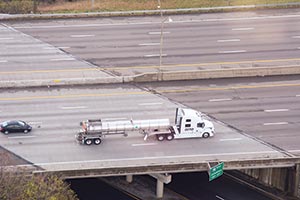Managing Editor, Features and Multimedia
Self-Driving Truck Hauls Tanker in Ohio as State Invests in Smart Infrastructure

A semi-autonomous truck operated by technology firm Otto traveled on highways in Ohio last week as the state announced a $15 million investment in smart infrastructure, its latest effort to support the testing of automated vehicles.
Otto’s truck transported an empty de-icer tanker from Columbus to Bellefontaine in daytime traffic on Nov. 29 for the Ohio Department of Transportation, marking the first delivery by a self-driving truck in the state, an ODOT spokesman said.
Two drivers were aboard the truck as it traversed interstates 70 and 270 and U.S. Route 33, but they completed the main portion of that trip primarily with the self- driving mode engaged, Otto said. The company’s system uses onboard software and sensors to track lane markings and detect other vehicles and objects on the road.
AUTONOMOUS AUTUMN: Recent video coverage of autonomous vehicle developments
Ohio’s smart infrastructure investment, announced by Gov. John Kasich at a Nov. 30 press event, is intended to capture data that can help automotive researchers further refine such technologies.
The project will fund the installation of high-capacity, fiber-optic cable and embedded, wireless sensors along the state’s Smart Mobility Corridor, a 35-mile stretch of Route 33 between Dublin and East Liberty northwest of Columbus.
Kasich said that corridor will provide researchers with “the perfect location and state-of-the-art infrastructure for safely testing autonomous and connected vehicle technologies.”
At the conclusion of that event, Otto’s self-driving truck embarked on another demonstration run on the Smart Mobility Corridor. It also was scheduled to travel on the Ohio Turnpike on Dec. 1.
The Ohio demonstrations followed Otto’s delivery of 51,744 cans of beer for Anheuser- Busch on Oct. 20 in Colorado, which Otto hailed as the world’s first commercial shipment by a self-driving truck.
Unlike the delivery in Colorado, the Otto truck was not accompanied by a police escort in Ohio.
“It was driving in real-world conditions, and that’s what we wanted,” said ODOT spokesman Matt Bruning, adding that the truck appeared to have operated flawlessly during the run.
“There were no issues whatsoever,” he said. “If you didn’t know that it was a self-driving truck, you’d have had no idea.”
“This delivery serves as a proof of concept of how Otto’s technologies can be deployed here in the state,” said Ognen Stojanovski, Otto’s head of policy and government relations. “We hope to continue working closely with the state into the future.”
Otto, founded in January by former Google engineers, was acquired in August by Uber Technologies Inc., which also is testing self-driving cars in Pittsburgh.
The installation of sensors and the fiber-optic network along Ohio’s Smart Mobility Corridor is scheduled to begin in May.
ODOT said that project also will align with work to develop Columbus as a hub for intelligent transportation through a $40 million “Smart City” grant from the U.S. Department of Transportation and more than $90 million from private-sector partners.
Thomas Balzer, president of the Ohio Trucking Association, described the demonstrations last week as an “excellent opportunity” to showcase the state’s openness to the technology.
Automated driving systems have the potential to enhance safety by assisting the driver with automatic braking and preventing lane departures, he said, adding that “there is no better safety feature in the truck than an attentive, well-trained, skilled driver.”
Balzer also said OTA has participated in meetings with state lawmakers and public officials to promote a legislative and regulatory framework that does not hinder technology development.
Other technology suppliers also are looking to expand testing in Ohio.
An executive at Peloton Technology, which is developing a truck platooning system, said the company is participating in the Columbus Smart City project and also is in discussions with ODOT and the Ohio Turnpike.
“We’re moving forward with plans to do truck platooning in Ohio in 2017,” said Steve Boyd, co-founder and vice president of external affairs at Peloton. The company’s system uses connected vehicle technology to synchronize the braking of two trucks, enabling much shorter following distances that enhance aerodynamics.
Peloton previously conducted a series of tests in the state at the Transportation Research Center in East Liberty, as well as some on-road activity, he said.
While platooning offers a return on investment through fuel economy gains, the business case for self-driving trucks operating individually may be tied to the prospect of securing relaxed hours-of-service rules for those vehicles, said transportation technology consultant Richard Bishop.
Connected infrastructure technology such as Ohio’s Smart Mobility Corridor is not essential for automated vehicles, but it is useful to their development, he said. “Automation gets more robust when there’s data available from a government entity.”
Bishop also leads the Technology & Maintenance Council’s Future Truck task force on automated driving and platooning, which he said offers a place for system developers and fleets to discuss issues related to the evolution of automated trucking.

